Oil fuels Saudi real estate market boom
The Kingdom of Saudi Arabia is in the midst of a real estate boom. Riyadh, the capital and Mecca, the most sacred city in Islam, have experienced the highest of house price increases.
In the first half of 2008, several analysts estimate that real estate prices in Riyadh rose 40% - 90% from a year earlier. The price of land in the capital ranges from SAR400 (US$107) per sq. m. to SAR4,000 (USS1,067) per sq. m. This is significantly higher compared to only SAR156 (US$42) per sq. m. five years ago.
From 2002 to 2005, house prices rose 13.7% annually while average land prices rose 16.5% per year, according to the National Commercial Bank Capital (NCBC), the largest bank in the Middle East. In 2006, land price have risen 20% - 40% y-o-y.
The most expensive land in Saudi Arabia is found in the neighboring areas of Mecca’s Holy Mosque, which is projected to have reached SAR400,000 (US$106,700) per sq. m.

The growing demand combined with limited supply of housing units caused a surge in real estate prices over the past years.
Huge oil revenues from skyrocketing oil and petroleum prices in the global market is the primary driver for the strong economic growth and rising purchasing power of Saudis. Investments from neighboring Gulf States and liberalization of real property laws added to the boom in Saudi’s real estate market.
Oil-fuelled boom
Saudi Arabia, the world’s largest oil producer and exporter, is experiencing an oil market bonanza from historically high petroleum prices. Petroleum accounts for more than 75% of government revenues and 90% of exports. Saudi is also the recognized leader of the Organization of the Petroleum Exporting Countries (OPEC), giving it huge economic and political clout in the international scene.
More Global Property Guide pages: |
Mindful of the lessons from the 1970s to early 1980s oil price boom, the Saudis are spending their petrodollars cautiously this time. The government is reinvesting a large portion of its oil revenue windfall into the real estate sector and encouraging foreign investments.
In addition, because of recurrent fluctuations in the local stock market that started in 2006, many investors have shifted their focus into the real estate market primarily to the middle-income housing market.
After deep recession in the 1990s, a Foreign Investment Law was passed in April 2000 to encourage a service-oriented economy. Seven months later a new Real Estate Law allowed legally-resident non-Saudis to own real estate for their private residence, provided they get a license from the Ministry of Interior.
With the permission from the Ministry of Interiorm, the law also allows ownership of real estate by foreign investors in order for them to conduct their business activities and have accommodation for their employees. To prevent speculation, five years must elapse before property can be sold.
Skyrocketing housing demand
The demand caused by the sharp population growth outstrips the supply of residential houses. With low home ownership levels and a rising number of young middle-class Saudis, strong housing demand is likely to persist.
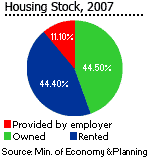
In 2007, there were 4.3 million occupied housing units in the kingdom. Around 44.5% of households live in owner-occupied units while another 44.4% live in rented units. Employer-provided housing units account for the remaining 11.1% of households.
The population of Saudi Arabia was around 24 million in 2007. The increase in population was attributed to two factors: the high natural growth rate of the Saudis at 3%-4% per year and the influx of expatriates, which accounted for 27% of the total population of Saudi Arabia.
In addition, the declining average household size in the kingdom is also expected to elevate the demand for housing units. From 6.08 persons in 2004, household size is expected to fall 5.49 persons in 2010.
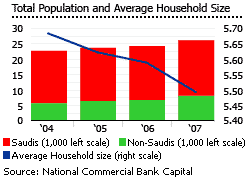
Recent surveys revealed that there is a shortage of more than 1 million housing units in Saudi Arabia.
The new Mortgage Law, expected to be passed before the end of 2008, is predicted to further intensify the demand for housing. Currently, the mortgage market in the kingdom is relatively underdeveloped. Consumer loans for real estate financing stand at only around 1% of GDP.
The rental market
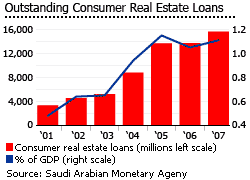
The rental market is attractive to investors because of high rental yields. Overall rental yields in Saudi Arabia are around 8%-9%, according to NCBC. Rising demand for rental units and the lack of adequate supply have led to massive rent increases.
In April 2008, housing rents were 20.4% up on a year earlier. There were reports that some landlords had raised rents by as much as 50%.
In 2007, the average monthly rent for a 3 bedroom house in Riyadh was around SAR12,750 (US$3,400), a 65% rise from a year earlier, based on the cost of living survey of UN International Civil Service Commission.
The residential rental market accommodates 37.5% (7.8 million) of the kingdom’s total population. A total of 1.9 million housing units are occupied on a rental basis, which is 44.4% of the aggregate housing stock. Saudis occupy 39% of the total rented units and the remaining 61% are rented by non-Saudis, mostly expatriates.
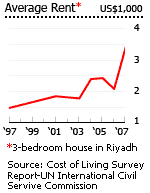
Housing construction boom
A multi-billion dollar construction boom is gaining momentum in the country with massive building and infrastructure projects underway.
Aggressive building and construction programs under the 8th Development Plan will further accelerate the economic growth, and are expected to solve the housing shortage in the country. Under this plan, the government expects to build more than 1 million housing units with extensive participation by the private sector.
Total residential building expenditure was around SAR39 (US$10.4) billion in 2006 and SAR47 (US$12.5) billion in 2007. In 2010, residential expenditure is projected to reach SAR65 (US$17.3) billion to meet the expected increase in housing demand.
| Government Programs | |
|
Plan Target 2005-2009 |
||
| Total housing units constructed under the Plan | 172,607 | 393,180 | 283,300 | 300,000 | 1,100,000 |
| Government housing | 48,607 | 4,570 | 0 | 60,000 | 225,000 |
| Private sector housing | 124,000 | 388,610 | 283,300 | 240,000 | 875,000 |
| Total housing stock at the end of the Dev’t Plan | 871,700 | 2,850,000 | 3,126,540 | 3,990,000 | 5,090,000 |
| Source: Ministry of Economy and Planning | |||||
Low interest rates and high inflation
The Saudi riyal is pegged to the US dollar at 1US$=SAR3.75. Because of this, local monetary policy should align with that of the US. When the US Fed repeatedly cuts its key interest rate to reduce the impact of the credit crisis, the Saudi Arabian Monetary Agency (SAMA), the kingdom’s central bank, is forced to cut key interest rates as well.
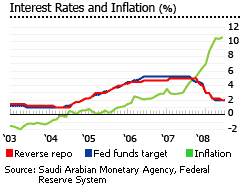
In June 2008, SAMA reduced the reverse repo rate to 2% from 5% a year earlier. However, an interest rate cut is the last thing the country needs. The depreciation of the US dollar against major currencies combined with rising global food prices has led to soaring inflation since Saudi imports bulk of its food requirements.
Rising food prices and rents pushed inflation to its 30-year high of 10.6% in June 2008.
Major developments in the real estate market
The Saudi government has launched four integrated economic cities, and is launching another two later this year - one in Tabuk and one in the Eastern Province. These huge projects aim to meet residential and commercial property needs and to improve the investment climate in the country.
These economic cities will create over 1.3 million jobs and house more than 4.5 million residents, contributing SAR563 (US$150) billion to GDP and increase Saudi Arabia’s per capita GDP to SAR125,625 (US$33,500) by the year 2020, according to the Saudi Arabian General Investment Authority (SAGIA).
| Project | Location | Total Area | |
Scheduled Completion | Value (SAR) | Residential Area |
| King Abdullah Economic City (KAEC) | Rabigh, north of Jeddah | 168 million sq. m. | Q4 2005 | 100 Billion | Includes 260,000 apartments and 56,000 villas | |
| Prince Abdulaziz bin Mousaed Economic City (PABMEC) | Hail, north of Riyadh | 156 million sq. m. | Q2 2006 | 30 Billion | Develop 30,000 housing units | |
| Knowledge Economic City (KEC) | Holy city of Medina | 4.8 million sq. m. | Q2 2006 | 25 Billion | Develop 30,000 residential units | |
| Jazan Economic City (JEC) | Jizan, 725 kms south of Jeddah | 100 million sq. m. | Q4 2006 | 102 Billion | Include residential areas with complete amenities |